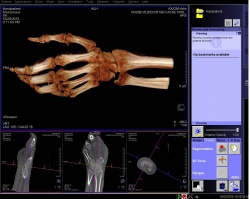Robotic
The Swiss Army knife of radiology
Not all innovations marketed as ‘world premieres’ actually make a significant impact on the world. However, the new robotic X-ray system ‘Multitom Rax’ (Robotic Advanced X-ray) introduced by Siemens Healthcare and the University Hospital Erlangen is one innovation in the world of medicine technology that deserves this label, the manufacturer reports. ‘With the combination of robotic and medical technology the company is moving into a completely new class and completely new technology,’ explains Siemens Healthcare CEO Dr Bernd Montag, introducing the new system.
Report: Sascha Keutel


The Multitom Rax has two ceiling-mounted arms, which can be positioned automatically with robotic technology but also manually via servomotors if required. One arm moves the X-ray tube and the large touchscreen while the other carries the flat panel detector, which is 43cm x 43cm in size. This facilitates both static and dynamic images as well as fluoroscopic sequences. The user retains control of the system’s movements at all times via remote control. The robotic technology moves the arms around the patient in a fully automated manner in the style of the ‘Mars robot’.
‘This type of technology allows an entirely new degree of precision and automation,’ explains Francois Nolte, head of the business line X-ray products at Siemens Healthcare. It therefore also leads to more standardisation and a higher patient throughput.’ The patient does not have to be repositioned, which also makes the examinations less painful. Nolte explains: ‘The exact positioning of the robotic arms in all axes makes the examinations a lot easier: Whether the patient stands, sits or lies down, the robotic arms can approach him with precision. Our concept follows the motto: The scanner moves and not the patient.’
Optimising clinical workflows
Apart from more quality, improved workflow and increased precision, the new system will also improve the economic efficiency of medical care. Instead of having to acquire different equipment for different examination rooms, hospitals will only need to acquire one system for one room as the system can also be used to carry out fluoroscopy examinations and angiography applications along with the conventional 2-D X-ray images. This helps greatly with the optimisation of workflows.
‘The Multitom Rax is designed as a universal device covering the entire range of X-ray diagnostics. It is, so to speak, like a Swiss Army knife for radiology,’ explains Professor Michael Lell, Senior Consultant at the Institute of Radiology at the University Hospital Erlangen, in Germany.
Another innovation is also very important for the radiologist, Siemens points out. The Multitom Rax can generate 3-D images in real-time. Images taken while the patient is standing are particularly important for diagnosis finding because the knees, pelvis and spine visualise in a different way under body weight from when a patient lies down. This provides considerably more safety for the diagnosis.
Fine, hairline bone fractures are not always visible on conventional 2-dimensional X-ray images, necessitating additional CT scans, which in turn consume more time and, of course, incur more costs. The system therefore helps with long-term improvements in economic efficiency for hospitals, Bernd Montag is convinced. His conclusion: ‘It will clearly be more expensive for hospitals not to have the new system.’
04.04.2016











